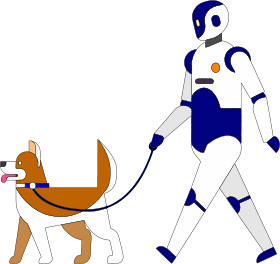Dog-Human interactions can help us develop more social robots.
The behaviors that highlight canine evolution to become ‘human’s best friend’ will teach us to understand and apply some of those behaviors toward the development of an improved human-robot relationship.
In a step towards development of robots that can interact meaningfully with humans, a new study, published in the scientific journal PLOS ONE, researchers from the University of Glasgow, Scotland, share insights on specific dog behaviors that dog owners perceive as important for bonding with their pets.
Why is this important?
Robots with social behaviors have been proposed as a potential solution to ease people’s loneliness and the challenges of aging. Given the difficulty of creating robots that behave like humans, and the known benefits of the bond between owners and their dogs, some researchers are exploring the possibility of developing dog-inspired robots that can form similar bonds with humans. However, this endeavor requires a deeper understanding of specific dog behaviors that facilitate human-dog bonds.
The Study
Researchers conducted a survey study of 153 dog owners. They asked the participants open-ended questions about which dog behaviors they felt were especially important in establishing and maintaining their bond with their dog.
Owners described a wide range of key behaviors, such as nudging the owner with a paw or looking back at the owner on walks, which appeared to facilitate such perceptions as the dog being protective or checking in with the owner. Other behaviors demonstrated a ‘connectedness’ or response to a gesture or sound.
In analyzing the responses, 7 core categories of behaviors were identified that owners described as important:
-
- attunement
- communication
- consistency and predictability
- physical affection
- positivity and enthusiasm
- proximity
- shared activities.
Graphic of Seven Categories of Behavior
Continuing Research
Meanwhile, other research could further investigate the dog—human bond, such as by exploring variations in preferences for dog behaviors among people with different backgrounds and demographics.
The authors add: “Using a qualitative approach enabled us to gain a deep and nuanced understanding of the things people find so endearing about our canine companions. While it won’t be easy to model most of these behaviors on robots, this work offers new and exciting insights for those working to develop pet-like technologies.”
There are however, ethical and moral issues that will become increasingly important and urgent to consider. Specifically, a number of researchers have raised concerns that by creating the illusion of intelligence or intentionality, people are being deceived by technology. Ethically, this is proposed to be especially problematic when it comes to the deception of vulnerable people, such as children, individuals with additional needs, and people suffering from dementia. Moving forwards, when designing behaviors for a robotic dog, it will be necessary to consider such issues, weigh up the benefits and risks of robot deception, involve researchers from a broad range of disciplines to contribute to design and regulation (including law, ethics, social sciences, developmental psychology, etc), and be mindful of the state of public opinion at that time of creation and deployment.
Afterthought
If we consider the variety or array of interactions that each of us have with our canine family, it is easy to become awestruck by how well they read us, how much they know and understand about us, how attentive they are, and finally, how they are truly capable of influencing or changing our behavior.
[Link to PLOS Research article]

